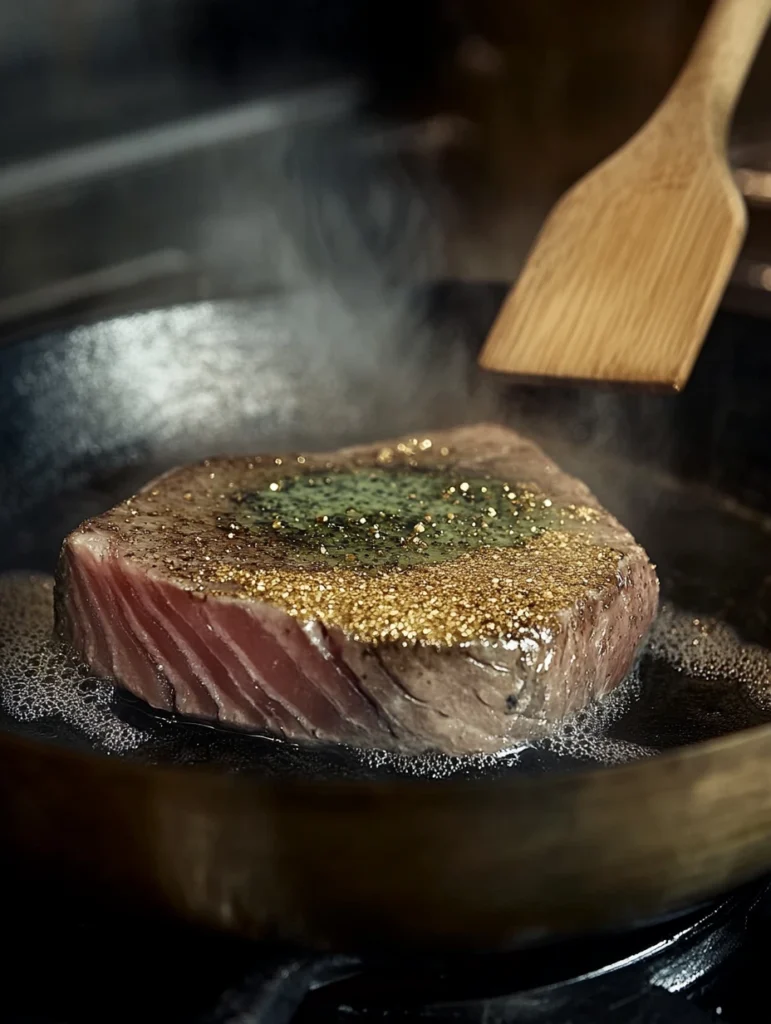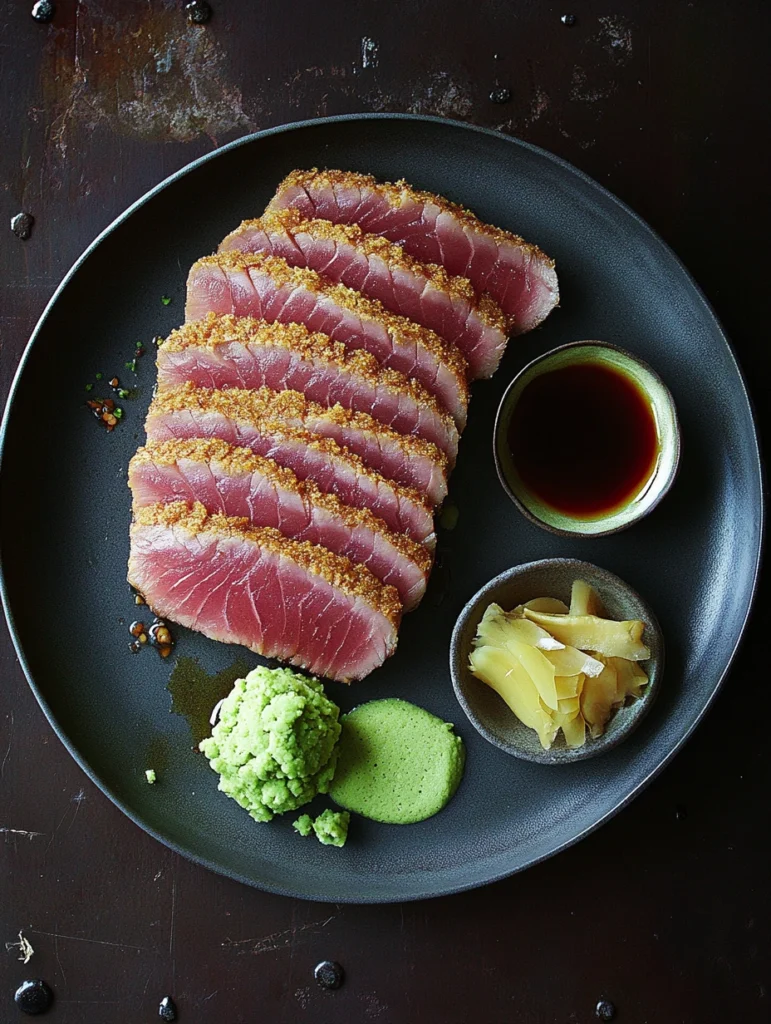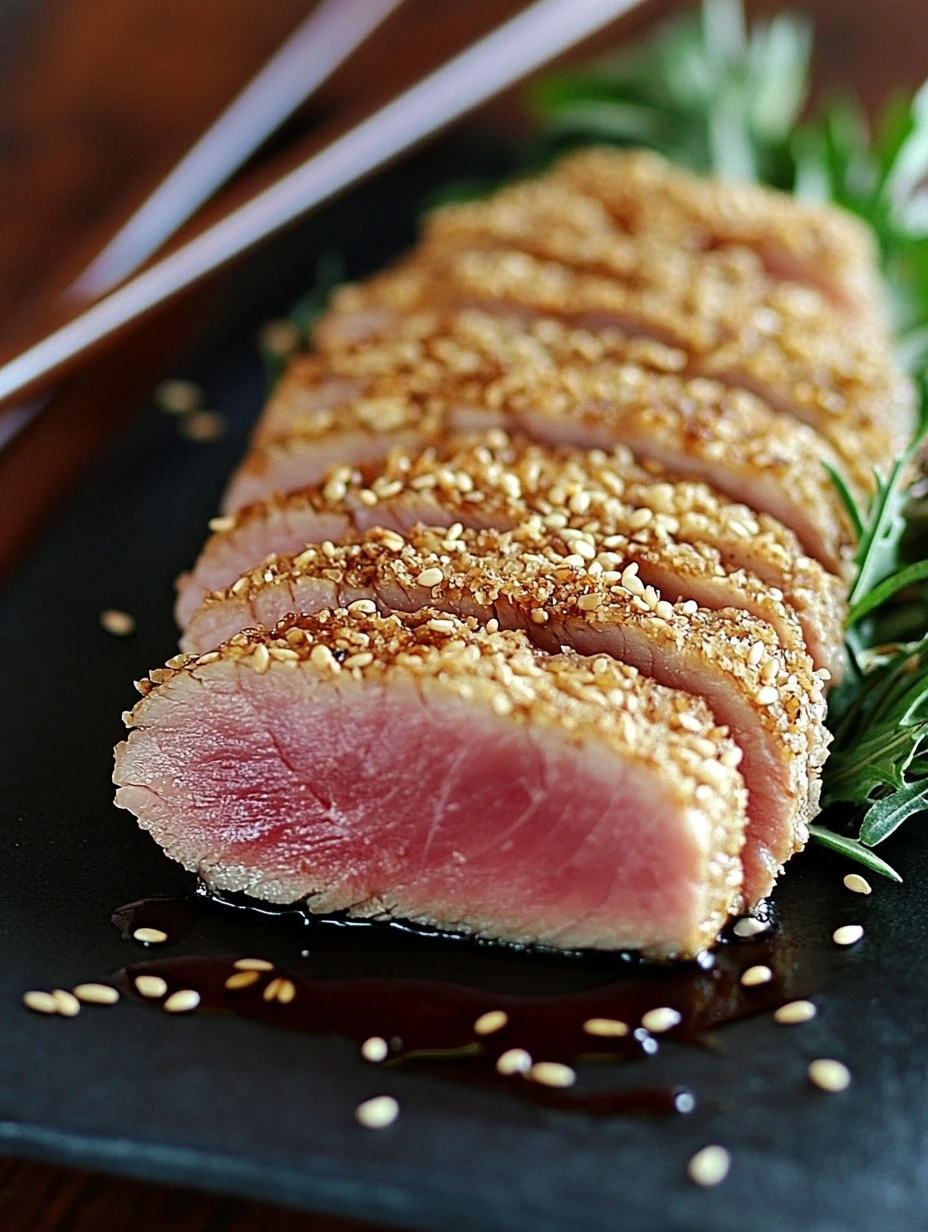Is It Better to Sear Tuna in Butter or Oil? A Complete Guide
Few things compare to the rich, melt-in-your-mouth texture of a perfectly seared tuna steak. But when it comes to achieving that crispy, golden crust, one question divides home cooks and professional chefs alike: Is it better to sear tuna in butter or oil?
Both butter and oil bring something unique to the table. Butter adds a rich, nutty depth of flavor, while oil—especially those with a high smoke point—ensures a crispier, more even sear. So which one should you use?
This guide breaks down the science of searing, the pros and cons of butter and oil, expert techniques, and the best choice for different cooking styles. Whether you’re aiming for a restaurant-quality crust or just want a simple, no-fuss sear, we’ve got you covered!
Introduction to Searing Tuna
Why Searing Tuna is Important
Unlike beef or chicken, tuna steaks are best enjoyed rare to medium-rare, meaning the inside stays cool while the outside gets that deeply caramelized crust. This cooking technique not only enhances the texture but also intensifies the natural umami flavors of the fish.
The secret to achieving the perfect sear lies in two key factors: high heat and the right fat. Whether you’re using ahi tuna, yellowfin, or bluefin, you need a fast, high-temperature cook to keep the inside tender while forming a beautifully crisp crust on the outside.
The Debate: Butter vs. Oil – Which One is Better?
So, is it better to sear tuna in butter or oil? That depends!
- Butter offers a rich, creamy taste but has a low smoke point, which means it can burn quickly.
- Oil, especially high smoke point oils like avocado or peanut oil, can withstand higher heat and give tuna that crisp, golden-brown sear.
- Some chefs use a combo of both, starting with oil for the sear and finishing with butter for added flavor.
we’ll dive deeper into the science of searing, compare the advantages of butter and oil, and help you decide which is best for your cooking style.
The Science Behind Searing Tuna
Searing isn’t just about cooking—it’s a chemical reaction that transforms the texture and flavor of food. When deciding, is it better to sear tuna in butter or oil?, understanding the science behind searing can help you make the best choice.
The Maillard Reaction: How Searing Affects Flavor
When tuna hits a hot pan, something magical happens—the Maillard reaction. This is the process where proteins and sugars in the fish react with heat, creating a beautiful golden crust and deep umami flavors.
- High heat is key: To trigger the Maillard reaction, you need a surface temperature of at least 300°F (150°C).
- Fat helps conduct heat: Butter and oil act as a barrier between the pan and the tuna, preventing sticking while enhancing the crust formation.
Ideal Temperature for Searing Tuna
Tuna should be seared at a high temperature for a short time to keep the inside tender and rare.
- Optimal searing temp: Between 400–450°F (204–232°C).
- Cooking time: Around 30–45 seconds per side for a perfect sear.
- Why fast cooking matters: Overcooking dries out the tuna, making it chewy instead of tender.
Does the Cooking Fat Affect the Final Taste?
Absolutely! The fat you choose impacts both flavor and texture.
- Butter adds a nutty, rich taste but burns quickly.
- Oil allows for a crisper crust and is more heat-resistant.
- A combination of both gives the best of both worlds!
Now that we understand the science, let’s dive into the benefits and drawbacks of using butter for searing tuna.
Searing Tuna in Butter – Pros & Cons
If you love rich, restaurant-style flavors, butter might seem like the obvious choice. But is it actually the best for searing? Let’s take a closer look.
Why Butter is a Popular Choice
Butter isn’t just for baking—it’s a game-changer for searing tuna. Here’s why many chefs swear by it:
- Adds depth of flavor: Butter contains milk solids, which brown as they cook, creating a nutty, complex taste.
- Creates a smooth crust: The fat content in butter helps develop an even, golden-brown sear.
- Pairs well with tuna: Its creamy texture enhances the delicate, umami notes of the fish.
Flavor Enhancement: How Butter Affects the Taste
If you want a buttery, slightly caramelized crust, butter is an excellent choice.
- When heated, butter undergoes a browning process, releasing rich, aromatic flavors.
- It blends well with seasonings like garlic, lemon, and herbs, making it ideal for European-style tuna dishes.
Smoke Point Considerations: Can Butter Handle High Heat?
One major drawback of butter is its low smoke point.
- Regular butter burns at around 350°F (177°C), which is much lower than the optimal searing temp for tuna.
- Burnt butter creates a bitter taste and can cause uneven searing.
- Clarified butter (ghee) is a better option, as it has a higher smoke point (450°F/232°C).
Best Techniques for Searing Tuna in Butter
If you want to use butter without burning it, here’s how:
- Use a mix of butter and oil: Start with oil for heat resistance, then finish with butter for flavor.
- Lower the heat slightly: Medium-high heat prevents butter from scorching.
- Baste the tuna: Spoon melted butter over the fish while cooking to infuse it with flavor.
Should You Use Butter for Searing Tuna?
Butter is fantastic for flavor but requires careful heat control. If you want a crispy, deep sear, oil might be the better option—let’s explore that next!
Searing Tuna in Oil – Pros & Cons

While butter adds rich flavor, oil is the go-to choice for achieving a perfectly crisp, golden sear. But is it really the best option? Let’s break down the advantages and drawbacks of using oil for searing tuna.
Why Oil is a Great Choice for Searing
Many professional chefs prefer oil over butter when searing tuna, and for good reason:
- Higher heat tolerance – Oil has a higher smoke point, which means it won’t burn as fast as butter.
- Better crust formation – The heat distribution in oil helps create a perfectly crispy exterior without scorching.
- Neutral flavor – Unlike butter, most cooking oils don’t interfere with the natural umami-rich taste of tuna.
Best Oils for High-Heat Cooking
Not all oils are created equal! Some perform better than others when it comes to searing at high temperatures. Here are the best choices:
- Avocado oil – Smoke point: 520°F (271°C) → Ideal for ultra-hot searing.
- Grapeseed oil – Smoke point: 420°F (216°C) → Great for a clean, neutral sear.
- Canola oil – Smoke point: 400°F (204°C) → Affordable and easy to use.
- Sesame oil (toasted) – Smoke point: 410°F (210°C) → Adds a rich, nutty flavor.
Oils to avoid: Olive oil and butter have lower smoke points, making them less ideal for high-heat searing.
Smoke Points of Different Oils
| Oil Type | Smoke Point (°F) | Best For Searing? |
|---|---|---|
| Avocado Oil | 520°F (271°C) | ✅ Excellent |
| Grapeseed Oil | 420°F (216°C) | ✅ Good |
| Canola Oil | 400°F (204°C) | ✅ Good |
| Sesame Oil | 410°F (210°C) | ✅ Adds Flavor |
| Olive Oil | 375°F (190°C) | ❌ Too Low |
How Oil Affects the Texture and Crust of Tuna
When oil is used correctly, it enhances the texture of the tuna without overpowering the flavor:
- A quick, high-heat sear with oil locks in moisture, preventing dryness.
- Oil allows even browning, giving the tuna a smooth, uniform crust.
- Some oils, like sesame or peanut oil, add subtle nutty undertones, complementing the natural richness of tuna.
Should You Use Oil for Searing Tuna?
If your goal is a crisp, even sear with minimal risk of burning, oil is the better choice. However, combining oil and butter gives you the best of both worlds—let’s compare them head-to-head in the next section!
Butter vs. Oil – Which is Better for Searing Tuna?
At this point, you might be wondering: Is it better to sear tuna in butter or oil? The truth is, both have their strengths and weaknesses. Let’s compare them side by side.
Taste and Texture Comparison
| Feature | Butter | Oil | Best Choice |
|---|---|---|---|
| Flavor | Rich, nutty, deep | Neutral or nutty (depends on oil) | Butter (for taste) |
| Crust | Softer, golden | Crispier, more even | Oil |
| Smoke Point | Low (350°F) | High (400–520°F) | Oil |
| Burn Risk | High | Low | Oil |
| Best For | Flavor enhancement | High-heat searing | A combination |
Key Takeaways:
- For flavor: Butter wins. Its richness enhances the natural taste of tuna.
- For crispiness: Oil is better. It achieves an even, golden crust without burning.
- For high-heat cooking: Oil is safer. It can withstand extreme temperatures without breaking down.
Health Considerations: Which is the Healthier Option?
- Butter contains saturated fats, which can add richness but should be consumed in moderation.
- Oils like avocado and grapeseed provide heart-healthy unsaturated fats, making them a better choice for those watching cholesterol.
Best Choice for Different Cooking Styles
Still wondering is it better to sear tuna in butter or oil? Here’s how to decide:
- For a traditional sear → Use oil (avocado or grapeseed) for a high-heat, crispy crust.
- For extra richness → Start with oil, then finish with a bit of butter for flavor.
- For lower-heat cooking → Use clarified butter (ghee) for flavor without burning.
Final Verdict: If you want crispiness and high-heat performance, oil is the better choice. But for depth of flavor, butter takes the lead. Combining both? That’s the ultimate pro move!
Expert Opinions & Cooking Techniques
When it comes to searing tuna, top chefs and cooking experts have their own tried-and-true techniques. But even among the pros, one question remains: Is it better to sear tuna in butter or oil? Let’s see what the experts have to say.
How Professional Chefs Sear Tuna
Most chefs agree on one thing—high heat is key. Whether using butter, oil, or a mix of both, the secret to a perfect sear lies in quick cooking and precise timing.
- Gordon Ramsay, a master of seafood cooking, prefers a quick, high-heat sear using oil, sometimes finishing with a touch of butter for extra richness.
- Chef Nobu Matsuhisa, known for his Japanese fusion cuisine, often uses neutral oils like grapeseed or canola to preserve the tuna’s delicate flavor.
- Alton Brown, a food scientist and TV chef, recommends using clarified butter (ghee) if you want buttery flavor without burning.
Gordon Ramsay’s Approach to Searing Tuna
Gordon Ramsay has a signature way of cooking seared tuna that results in a perfectly crisp exterior and a rare, tender center. Here’s his method:
- Season the tuna – Lightly coat with salt, pepper, and sesame seeds for texture.
- Use a high-smoke-point oil – Ramsay typically sears tuna in grapeseed or avocado oil.
- Sear for 30–45 seconds per side – The goal is a crisp, golden crust while keeping the inside rare to medium-rare.
- Finish with butter – A small amount of butter is added at the end for richness and extra flavor.
- Rest before slicing – Let the tuna sit for a minute or two before slicing thinly against the grain.
Tips for Achieving the Perfect Seared Tuna at Home
- Use a heavy pan – A cast-iron skillet retains heat best for a deep, even sear.
- Pat the tuna dry – Excess moisture can prevent proper browning.
- Don’t overcook – Tuna should be rare to medium-rare inside for the best texture.
- Experiment with seasonings – Try adding garlic, soy sauce, or a citrus glaze for extra depth.
Using these expert techniques, you can recreate restaurant-quality seared tuna right in your own kitchen!
FAQs – Answering Common Questions
When deciding is it better to sear tuna in butter or oil?, many home cooks have additional questions. Here are some of the most frequently asked ones.
Is it better to sear ahi tuna in oil or butter?
For high heat and a crispy crust, oil is the better choice. However, if you want extra flavor, you can finish with a small amount of butter after searing.
Is it better to sear with oil or butter?
It depends on the cooking temperature. Butter adds flavor but burns easily, while oil with a high smoke point is better for high-heat searing. If unsure, use both!
What’s the best way to sear tuna?
- Use a heavy skillet (cast iron or stainless steel).
- Heat oil to 400–450°F for a quick sear.
- Sear each side for 30–45 seconds for a rare center.
- Let the tuna rest before slicing for the best texture.
How does Gordon Ramsay sear tuna?
Chef Gordon Ramsay uses a neutral oil like grapeseed or avocado for a hot, quick sear, then adds butter at the end for extra richness and depth of flavor.
Final Thoughts
So, is it better to sear tuna in butter or oil? If you want a crisp, even sear, go with oil. But if flavor matters more, butter (or a combo of both) is the way to go. Try both methods and see which works best for your taste!
Best Ways to Cook and Enjoy Seared Tuna

Once you’ve decided is it better to sear tuna in butter or oil?, it’s time to explore delicious ways to cook and serve it. A perfectly seared tuna steak can be the star of a simple meal or an elegant gourmet dish.
Best Cooking Methods for Seared Tuna
Seared tuna is incredibly versatile, and the cooking method you choose can impact the texture, flavor, and overall experience.
- Classic Pan Sear – The most popular method, using a hot skillet and high smoke point oil, sometimes finishing with butter for extra flavor.
- Grilled Seared Tuna – Using a well-oiled grill, this method creates a smoky charred crust while keeping the inside rare.
- Sous Vide with a Sear Finish – For precise temperature control, sous vide cooks tuna perfectly, then a quick butter or oil sear adds the crust.
Each method offers unique benefits, but they all rely on the same principle: a short, high-heat sear for a golden-brown crust and a tender center.
Best Seasonings and Sauces for Seared Tuna
A well-seared tuna steak pairs beautifully with light, fresh flavors. Here are some great options:
- Simple seasoning – Salt, black pepper, and sesame seeds enhance the natural umami flavor.
- Soy-Ginger Glaze – A mix of soy sauce, ginger, honey, and sesame oil adds an Asian-inspired touch.
- Lemon Butter Drizzle – Melted butter, lemon juice, and garlic create a rich, citrusy sauce.
- Spicy Sriracha Mayo – Perfect for serving seared tuna in poke bowls or sushi-style dishes.
Whether you choose oil for crispiness or butter for extra richness, the right seasonings and sauces can take your tuna to the next level!
Expert Insights and Advanced Cooking Techniques
To settle the question is it better to sear tuna in butter or oil?, let’s look at advanced cooking insights from culinary experts.
What Professional Chefs Recommend
Most chefs agree on one thing—for a perfect sear, high heat and the right fat are essential.
- Chef Gordon Ramsay – Uses grapeseed oil for the initial sear, then finishes with butter for depth of flavor.
- Chef Nobu Matsuhisa – Prefers neutral oils like canola or sesame oil to let the tuna’s natural taste shine.
- Chef Thomas Keller – Recommends clarified butter (ghee) for those who love butter but want to avoid burning it.
Pro Tips for the Ultimate Sear
Want restaurant-quality seared tuna at home? Here are some expert-level tips:
- Use a cast-iron skillet – Retains even heat, creating a perfectly crisp crust.
- Pat the tuna dry before searing – Moisture prevents browning, so always dry the surface first.
- Sear at 400–450°F for 30–45 seconds per side – Anything longer will overcook the inside.
- Rest before slicing – Letting the tuna sit for a minute or two helps lock in juices.
Final Verdict: Butter, Oil, or Both?
So, is it better to sear tuna in butter or oil? The answer depends on your priorities:
- For a crisp, golden crust → Use high smoke point oil like avocado or grapeseed.
- For rich, nutty flavor → Add butter at the end for extra depth.
- For the best of both worlds → Start with oil, finish with butter!
At the end of the day, the best method is the one that suits your taste. Experiment, try different techniques, and discover what works for you!

